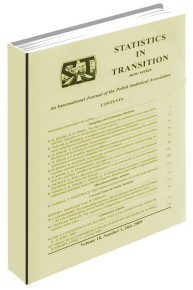Maternal Nutritional Status and Lactational Amenorrhea in India: a Simulation Analysis
Maternal Nutritional Status and Lactational Amenorrhea in India: a Simulation Analysis
Author(s): Laxmi K. DwivediSubject(s): Economy
Published by: Główny Urząd Statystyczny
Keywords: simulative approach;maternal nutritional status;body mass index;postpartum amenorrhea;India
Summary/Abstract: Apart from breast-feeding, socio-economic and biological factors, maternal health also influences the length or distribution of waiting time to conception. The main objective of this paper is to examine the linkages between maternal nutritional status (measured by body mass index-BMI) and postpartum amenorrhea among currently breast-feeding women in India and its region. Further, the probability to remain amenorrheic through simulative approach has been estimated to get better understanding of the impact of maternal nutritional status on postpartum amenorrhea. Using National Family Health Survey-2 data, women who were not pregnant, who were breast-feeding and who were not using any hormonal contraceptives at the time of the survey were included in the analysis. Missing cases for body mass index and child nutritional status were imputed by fitting the linear regression equation. There was no significant difference existing between mean BMI of each region of India before and after imputation of missing cases. The interaction term between maternal nutritional status and duration of breast-feeding (child’s age) was significantly associated with the likelihood of having resumed menstruation after controlling for breast-feeding practices, child nutritional status and socio-economic and demographic covariates. The effect of maternal nutritional status on lactational amenorrhea was not found to be significant when women were breast-feeding since last 12 months except in the northern region of India. However, after 12 months of breast-feeding, the probability of undernourished women to remain amenorrheic was likely to be greater and this trend was highly consistent across all the six regions included in the analysis.
Journal: Statistics in Transition. New Series
- Issue Year: 14/2013
- Issue No: 1
- Page Range: 107-128
- Page Count: 22
- Language: English

